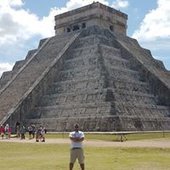I'm trying to put together some form of visibility control for a top down strategy game/experiment and I'm considering going out on a limb by introducing fog of war in a way that I don't think has really been done before.
Basically the idea is to give the player vision of only the things that his units can see while masking out the rest of the terrain pretty almost completely. In essence this is simplified fog of war from any strategy game that has one. Here's the idea in action: close up, the player can see the unit's immediate surroundings. Each unit has its vision radius, which is further compounded by environmental factors.
For reference - the green blobs on the map are the Shetland islands off the northern coast of the UK. This should provide a sense of scale. The first image is also the minimum zoom at which I would assume the player plays the game (they can zoom in closer):
[attachment=26875:close.jpg]
As they zoom out, however, it quickly becomes apparent that what is visible in practice is a noticeably small portion of the actual world. Here's the same area from a bit further out:
[attachment=26876:closer.jpg]
Zooming out completely reveals the true limited nature of visibility:
[attachment=26877:wholeworld.jpg]
The last screenshot contains the whole of Northern Europe.
All of this is pretty much standard, but my idea is to:
1) provide the player with no permanent visibility at all, meaning that any area that isn't near a unit is permanently shrouded
2) provide the player with an adaptive system that reduces the shroud based on something like their cartography skill and the number of times they have traversed an area with a unit
3) the same as 3, but the player has clear visibility of only the active unit. This means that the minimap (which would be pretty much redundant before the player is given the ability to actually map the world) only shows units that have direct line of sight between each other. Cycling through units would provide no sense of position or relevance at all - the units could easily be just barely out of each other's sight or they could be half a world apart. The player would have no immediate way of knowing.
4) if the above two seem too limiting, resort to Civilization style fog of war: any tile that the player can see directly is fully revealed and any tiles they have not yet discovered are shrouded completely
I'm personally rather fond of approach 3, but I do realize that penalizing the player's ability to orientate may seem excessive - especially nowadays. The point here is, though, that one of the focuses of the game will be on exploration and I want the player to be wary of haphazardly sending out units - after all, when Columbus set sail for the new world, stars and the Sun were the only things they had to go by. Mapping the world at the time was very much prone to error and maps were usually very crude. My objective is to think of a way tap into this sense of exploration without ruining the gameplay in the process.
I'd appreciate some quick thoughts on how to best achieve this. Does this (in particular number 3) seem like an interesting approach or does it rather feel annoying?
I don't really have a working prototype yet so I it's not really possible to mess around with the idea, but some thoughts and discussion would still be nice ![]() .
.












